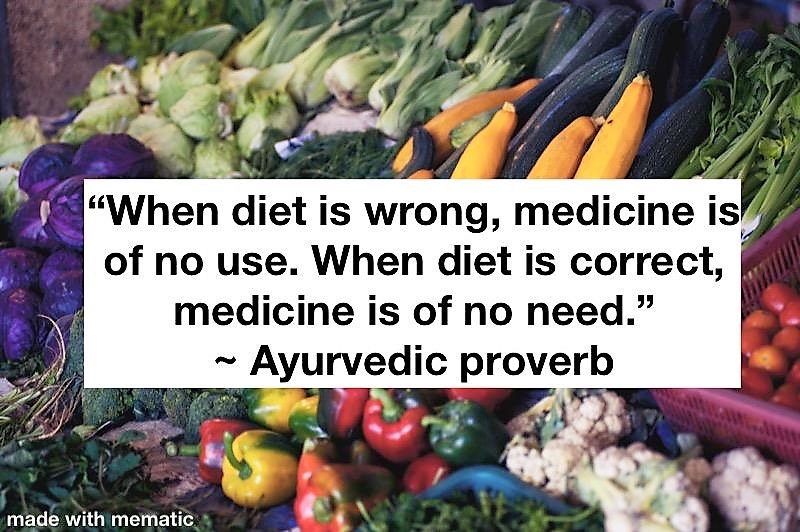
This is my third installment in a series of blogs I’m dedicating to the ancient sister science of Yoga—Ayurveda. Here are links to the first two in case you missed them:
The Science of Life: How to hone and own your best assets
We covered zeroing in on just what your energetic personality type is in the first blog and tackled the Ayurvedic clock / circadian rhythms last week. Now that you know who you are and what your preferences are, as well as the best times to wake, eat and sleep; we’ll touch a bit on just what to eat for your type. Reviewing the past two blogs will help you here.
Six Tastes
Remember opposites soothe and similar aggravates. Each dosha, or energetic personality type, has tastes that pacify and soothe their dosha. There are six tastes: Sweet, sour, salty, bitter, astringent and pungent. Ayurveda recommends that we have all six tastes in our diet and preferably in each meal. The key is to eat these in appropriate amounts for your “constitution”/doshic balance.
Sweet: Pacifies both Vata and Pitta but increases Kapha.
Sour: Increases (or aggravates) Pitta and Kapha and it decreases (or pacifies) Vata.
Salty: Moderate use relieves Vata but increases Kapha and Pitta.
Pungent: Pacifies Kapha but excites/aggravates Pitta and Vata. If you eat a little bit of pungent, the first action of pungent is to pacify Vata due to the heat qualities. Using it too much, however, will dry so it increases Vata (already dry) and Pitta (fire element is one of Pitta’s components and is already drying).
On a side note, when I took an in-depth 9-month study on Ayurveda in 2014 (Living Ayurveda with Cate Stillman), I started to drill down on just what spices and foods do to our mentality, mood, and body. I used to absolutely love cayenne! I’d sprinkle cayenne on literally everything! I mean you could see red on my salad! Then I read that pungent in excess makes you …angry, irritable, aggressive, competitive, jealous, envious, and even violent. Makes sense, doesn’t it? What goes in must come out. Pungent is hot, sharp and penetrating. In small quantities that’s good. In excess, not so much!
Bitter: Increases Vata but decreases Pitta and Kapha. Bitter is the most lacking taste in North America. This may be why coffee is so popular—it’s bitter. However, you know how some research shows too much coffee will cause bone loss? Over-consumption of bitter can reduce bone marrow and lead to bone loss. There are many qualities I could go into here, but won’t for now.
Astringent: Reduces both Pitta and Kapha, but increases Vata.
Favorite Tastes
Vata Dosha
Vata prefers sweet, sour, and salty foods to soothe and balance their dosha.
Pitta Dosha
Pitta prefers sweet, bitter, and astringent foods to soothe and balance their dosha.
Kapha Dosha
Kapha prefers bitter, pungent, astringent foods to soothe and balance their dosha.
Toxins / Ama
Let me just add a quick note on toxins in our body (“ama” in Ayurveda). If you are consuming a lot or processed food, or not using organic vegetables (especially for the infamous “dirty dozen”), or using chemical-laden cosmetic and cleaning products; you’ll probably have some toxicity in your digestive system.
Our body is so well-designed that without the toxicity, our cravings are healthy. Our body will actually crave those things that will balance our doshas! How cool is that? Cellular intelligence at its finest! However, and this is a biggie, if you have digestive issues due to toxins or other considerations, our cellular intelligence is off and our cravings become what Ayurveda likes to refer to as “perverted”.
Modern science is catching up to the ancients here. I’ve read recent studies that if we eat the wrong foods, we feed the wrong microbes in our gut. What we feed grows and wants to stay alive so the cravings will be more of the same—“Feed me!”
So part of the healing process of our gut is to start eating the good stuff, right? Then once we remove the toxins from our diet, our cravings will be healthy ones.
A few other things that can lead to toxins could be overeating, eating heavy foods in excess or large heavy meals just before bed, eating hard to digest foods for your dosha, and eating at the wrong times (night, between meals, or unseasonally.)
My favorite Ayurvedic Cookbook
So I’ve highlighted some ideas for heading toward a balanced intake above. But what about some recipe suggestions? My favorite Ayurvedic cookbook is Eat, Taste, Heal: An Ayurvedic Guidebook and Cookbook for Modern Living. Each recipe is labeled with which dosha it’s appropriate for as well as how to adjust a particular recipe to be okay for a different dosha. Genius, right?! There’s also “Dosha food lists” in the appendices for easy reference.
Fruits as a starter list from the above cookbook
(There’s more, but this will get you going until you get the book!)
Vata would favor all berries, dates (a super food in Ayurveda), oranges, apricots, coconut, grapefruit, grapes, lemons, limes, and avocado (healthy fats!).
Pitta would favor apples, avocado, sweet berries, sweet apricots, dates, coconut, sweet grapes, mango, sweet plums, watermelon, and pomegranate.
Kapha would favor apples, apricots, berries, cherries, mango, peaches, pears, and pomegranate.
Vegetables starter list
Vata: favor cooked vegetables—asparagus (again a super food), beets, squash (winter, butternut and acorn), carrots, cucumber green beans, leeks, onions (remember cooked), sweet potatoes.
Pitta: Brussel sprouts, butternut and spaghetti squash, leafy greens, lettuce, cabbage, cauliflower, celery, fresh corn, cucumber, green beans, kale, collards, mushrooms, peas, parsley and sprouts.
Kapha: Broccoli, Brussel sprouts, cabbage, carrots, cauliflower, celery, collard greens, fresh corn, eggplant, horseradish, kale, leafy greens, leeks, lettuce, mushrooms, onions, peas, parsley, white potatoes, radish, and summer squash.
There are also categories for grains, legumes, dairy proteins, nuts, seeds, oils, sweeteners, herbs and spices, condiments, beverages, supplements. Too much to cover here!
Food combining
“Every food has its own taste, a heating or cooling energy, and a post-digestive effect. Some also possess an unexplained effect. When two or more foods having different taste, energy, or post-digestive effects are combined, your digestive fire, (Agni in Ayurveda), can become overloaded, inhibiting the enzyme system and resulting in the production of toxins. Yet these same foods, if eaten separately, might well stimulate your digestive fire, be quickly digested, and even help to burn toxins.” ~ Textbook of Ayurveda Volume 1, by Vasant Lad, MASc.
This is a very important topic that we don’t always consider. You’ve probably heard to eat fruit alone? This is one of the Ayurvedic recommendations. Improper food combining causes indigestion, gas, fermentation; and yes—disease, among other things. Here’s a quick chart to start your journey. Remember to start slow. It’s a process!
Kitchari: Kind of like Chicken Soup
Kitchari is a simply prepared meal. It’s also a great balancing, easily digested complete meal in a single dish. There are many recipes out there. In my current Ayurveda training with Yoga Veda Institute, they commented that while Kitchari comes from Ayurveda, each culture has their version—kind of like our chicken soup recipes. So explore your favorite Kitchari recipes online.
I hope you’ve enjoyed dipping your toe into eating with your doshas in mind. I’ve only touched upon some very basic concepts. The rest is up to you. I’m here to help if you have questions! See you next week for my fourth installment on Ayurveda!


